
Definition
See page 7.
Forms
English has fewer inflected verb forms than any continental European language. Many English verbs have only four forms (for example, talk, talks, talked, talking); some have five forms (for example, sing, sings, sang, sung, singing).
In some systems of grammar, it is said that, technically, English has only two tenses—present and past—and that other temporal concepts are expressed by periphrastic verbal constructions. This means that English uses helping verbs and other expressions to convey temporal differences. Verbs are presented here in a more traditional way, because it will help you see the parallels between English and French constructions. Following are the principal parts of an English verb.

Some words used to identify verb forms are conjugation, tense, voice, transitive, intransitive, and mood.
Conjugation
This word has two meanings.
1. In Latin and in modern Romance languages, verbs are classified into groups, or conjugations, by their infinitive endings. English and German have only regular and irregular (sometimes called weak and strong) verbs. Weak verbs take a regular ending to form the past (for example, talk~talked and follow ~followed). Strong verbs often change the vowel in their past forms and may look completely different from the infinitive (for example, sing~ sang and go ~went).
2. Conjugation also refers to a list, by person, of each form in a given tense. Latin has six forms in each tense. Following are the present-tense forms of amare (“to love”).
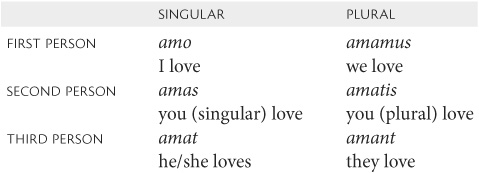
Since each form is different, it is not necessary to use a pronoun subject: The verb ending tells you who the subject is. The same is true for Spanish and Italian today.
In English, verbs can be conjugated but usually are not, because there is only one inflected ending: -s is added to the third-person singular of the simple present tense.

The pronoun (or a noun) is required with every verb form, because otherwise it would not be known who or what the subject is.
Tense
This word comes from Latin tempus via French temps, meaning “time.” The tense tells when something happened, how long it lasted, and whether it is completed.
Voice
English has two voices: active and passive. Active voice means that the subject is or is doing something.
Mary is happy.
Mary reads the newspaper.
In these examples, Mary is the subject.
Passive voice means that the subject is acted on by an agent. The verb tells what happens to the subject.
The newspaper is read by Mary.
In this example, newspaper is the subject.
Transitive verbs
These verbs require an object to express a complete meaning.
Mr. White surprised a burglar.
In this example, the verb surprised is transitive, because it takes an object, burglar. If we omitted the object, the sentence would not make sense; it would be incomplete.
Intransitive verbs
These verbs do not require an object.
Paul sat down.
Here, the verb sat is intransitive, because it has no object; down is an adverb.
English has many verbs that can be either transitive or intransitive.
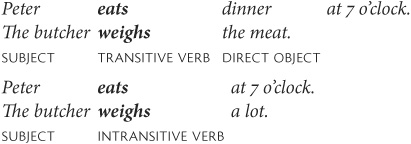
Mood
This grammatical concept indicates the mood, or attitude, of the speaker. Is the speaker stating a fact? Offering a possibility that has not happened yet? Making a recommendation? Giving an order? Three moods are used to express these ideas: indicative, imperative, and subjunctive. The indicative is by far the most common mood. The other two are used in special circumstances and are discussed below.
 Introducing questions
Introducing questionsForms
There are four ways to ask a question in English.
1. Place a question mark after a statement and raise the pitch of your voice at the end of the statement when saying it aloud.
Anne is here already?
That’s Mark’s idea?
2. Add a “tag,” repeating the verb or auxiliary verb as a negative question. In English, the specific tag depends on the subject and the verb.
Peter is happy, isn’t he?
They came on time, didn’t they?
3. Invert the subject and an auxiliary or modal verb or the verb to be.
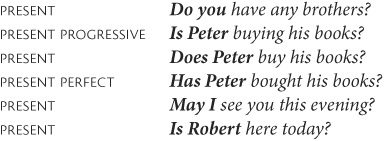
4. Use an interrogative word.
Where is the library?
When does the library open?
 Introducing questions
Introducing questionsForms
There are five ways to ask a question in French.
1. Place a question mark after a statement and raise the pitch of your voice at the end of the statement when saying it aloud. This method is usually limited to conversations (oral and written).
Anne est déjà ici?
C’est l’idée de Marc?
2. Place n’est-ce pas after a statement with which you expect the hearer or reader to agree.
Pierre est content, n’est-ce pas?
3. Invert the pronoun subject and verb. You do not need an auxiliary verb to form a question, as you do in English.
Avez-vous des frères?
Do not use inversion with je. In the third-person singular of -er verbs, add -t- to make pronunciation easier.
parlez-vous BUT parle-t- il, parle-t- elle, parle-t- on
If the subject is a noun, do not invert it with the verb. For example, to make a question of the statement Pierre achète ses livres,
a. state the noun first: Pierre…
b. invert the verb and the personal pronoun for Pierre (il): Pierre achète-t-il…
c. complete the sentence: Pierre achète-t-il ses livres?
4. Place est-ce que at the beginning of the statement.
Est-ce que la bibliothéque est ouverte?
5. Use an interrogative word, with or without verb-pronoun inversion and with or without est-ce que.
Où est la bibliothéque?
Quand la bibliothèque est-elle ouverte?
Quand est-ce que la bibliothèque est ouverte?
These rules apply to a simple tense (one in which the verb is expressed by one word). In compound tenses (those that use two or more words to form the verb), the auxiliary verb is treated in the same way as in simple tenses.
Avez-vous parlé?
Pierre a-t-il acheté ses livres?
Word order
WITH NEGATIVES The verb-pronoun group is joined by a hyphen. A hyphenated group may never be broken up. Thus, ne… pas (or any other negative form) is placed around the whole group.
Pierre n’a-t-il pas acheté ses livres?
WITH PRONOUN OBJECTS As with statements, pronoun objects go directly before the verb in questions.
Les avez-vous?
Vous a-t-il vu?
Ne m’avez-vous pas vu?
WITH OTHER KINDS OF QUESTIONS When you use intonation, n’est-ce pas, or est-ce que to ask a question, the word order is the same as for a statement. See the examples above.
Definition
Verbals are forms of the verb that are not finite, that is, do not agree with a subject and do not function as the predicate of a sentence. There are five types of verbals: present infinitive, past infinitive, gerund, present participle (also called the gerundive), and past participle.
 Present infinitives
Present infinitivesDefinition
The present infinitive is the basic form of the verb, as it appears in a dictionary.
Forms
The infinitive is often identified by the word to preceding it. However, to is omitted in many infinitive constructions, especially after verbs like can and let. Compare the following sentences, both of which contain the infinitive swim.
I know how to swim.
I can swim.
Uses
In addition to completing the verb, as in the above examples, an infinitive may serve as the subject or object of a sentence, as an adjective, or as an adverb.

Infinitives may also have their own direct objects and other modifiers.

 Past infinitives
Past infinitivesForms
The past infinitive is formed with the present infinitive of the auxiliary verb plus the past participle of the main verb.

Uses
The past infinitive is used in the same ways as the present infinitive.
To have quit is terrible.
 Present infinitives
Present infinitivesForms
French verbs are grouped in three conjugations by the ending of their infinitives: -er (the most common), -ir, and -re.
Uses
The French infinitive may be used in several ways.

The prepositions en and après do not take a present infinitive (see below).
Infinitives may have objects (either nouns or pronouns) and be negated or otherwise modified.

The negative ne pas precedes the infinitive.
 Past infinitives
Past infinitivesForms
Past infinitives are formed as in English, with the present infinitive of the auxiliary (avoir or être, depending on the verb) plus the past participle.

The past infinitive must be used with the preposition après.

 Gerunds
GerundsDefinition
Gerunds are often called verbal nouns.
Forms
The English gerund is formed by adding -ing to the infinitive form of the verb.

Uses
Gerunds have the same functions as other nouns (see page 10).

Gerunds may also have objects and modifiers.

 Participles
ParticiplesDefinition
Participles are verbal adjectives that constitute the third and fourth principal parts of a verb.
Forms
English has two participles.
1. Present participles (the fourth principal part) end in -ing.
singing
talking
managing
2. Past participles (the third principal part) end in -ed or -n for regular verbs.
tried
gathered
concentrated
given
To determine the past participle of an irregular verb, say, “Today I go; yesterday I went; I have gone; I am going.” The form used after “I have” is the past participle. In the dictionary, the principal parts are given for every irregular verb.
 Gerunds
GerundsFrench has no gerund; the infinitive is used as the verbal noun (see the first example above under present infinitives). Infinitives may be modified.
Gagner vite de l’argent, c’est le but de bien des gens.
 Participles
ParticiplesForms
French has two participles.
1. Present participles end in -ant. This ending is added to the first-person plural of the present tense after dropping the ending -ons.

Three French verbs have irregular present participles.

In order for all forms to keep the same consonant sounds as the infinitive, verbs ending in -cer and -ger make a slight, but regular, change to form the present participle: -Cer verbs put a cedilla under the -c-, and -ger verbs add -e before endings that begin with a or o.

2. Past participles have different endings for the different conjugations. For regular verbs, the infinitive ending -er, -ir, -re, or -oir is dropped, and -e, -i, or -u is added.

 Participles (continued)
Participles (continued)Uses
The two types of participles have the same basic uses.
1. As part of a compound verb (one consisting of two or more words)

2. As an adjective
a talking doll
a proven fact
3. In an absolute phrase modifying a noun
Walking along the street, he met Robin.
Seen from the front, the building was even more imposing.
In the two examples above, he is walking and the building was seen.
 Participles (continued)
Participles (continued)A number of French verbs have irregular past participles; following are some of the most common.*
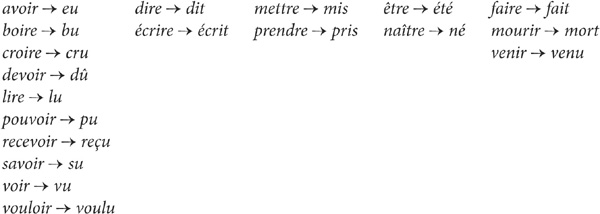
Uses
A present participle is used
1. after the preposition en to express “while doing something.”
En rentrant, j’ai vu Paul.
All other prepositions are followed by an infinitive.
2. as an adjective. (Adjectives ending in -ant were once verbals.)

3. as an absolute modifying a noun or pronoun.
Sachant qu’il est difficile, j’évite M. Jones.
A past participle is used
1. as a noun.

2. as an adjective.
un fait prouvé
3. as the second element of a compound verb form.
j’ai parlé
il aura fini
4. in an absolute phrase modifying a noun or pronoun.
Vu de face, le bâtiment était même plus imposant.
The verbs on pages 86–107 are all in the indicative mood. It is the one used for stating facts and for making assertions as though they were facts.
 Present tenses
Present tensesDefinition
The present tense is defined by its uses (see below).
Forms
There are three present tenses in English: simple present, present progressive, and present emphatic.
1. Simple present. There is only one inflected form in the simple present: the third-person singular, which adds -s to the basic verb form.

2. Present progressive. This tense is formed with the present tense of to be plus the present participle.

3. Present emphatic. This tense is formed with the present tense of to do plus the infinitive.

 Present tense
Present tenseForms
The French present tense is easier than English because there is only one tense, not three. It is more difficult, however, because each conjugation has different endings and because French has many more irregular verbs. One system of classifying irregular French verbs by their conjugation patterns may be found in Appendix C.
1. -er verbs. Drop the infinitive ending (-er) and add -e, -es, -e; -ons, -ez, -ent.

2. -ir verbs (finir type). Drop the infinitive ending (-ir) and add -is, -is, -it; -issons, -issez, -issent.

This pattern is used for all -ir verbs except those listed under dormir (below) and some irregular verbs (see Appendix C).
-ir verbs (dormir type). Drop the -ir ending and the final consonant (in the singular forms) of the infinitive and add -s, -s, -t; -ons, -ez, -ent.

Verbs like dormir include partir, sortir, servir, mentir, courir, and their compounds.
3. -re verbs. Drop the infinitive ending (-re) and add -s, -s, —; -ons, -ez, -ent.

Uses
The simple present is used for
1. an action or state occurring in the present.
They speak Chinese.
2. an habitual action that is still true.
I always study in the evening.
3. existing facts and eternal truths.
Paris is the capital of France.
I think, therefore I am. (René Descartes)
The present progressive is used to
1. stress the continuing nature of the verb’s action in either a statement or a question.
I am still trying!
Are you going to the library now?
2. make a future action seem more immediate.
We are reading this book next week.
I am going to the show tomorrow.
The present emphatic is used to
1. add emphasis or contradict.
I do want to do well.
They do not do that!
2. form questions or negative statements.
Do you go to the lake in the summer?
I do not know what you are talking about.
 Present tense (continued)
Present tense (continued)Uses
1. All of the uses listed for the three present tenses in English are filled by this one tense in French. To emphasize that one is in the act of doing something, use the idiom être en train de+ infinitive.

2. French uses the present tense with depuis to express an action begun in the past that is still going on in the present.

 Past tenses
Past tensesDefinition
The past tenses describe actions or states in the past.
Forms
There are three past tenses, each corresponding to one of the three present tenses discussed in the previous section. (For perfect tenses, see pages 96–105.)
1. The simple past is the second principal part of the verb (see page 76). It is not inflected; all of the forms are the same. The simple past of weak verbs ends in -ed (for example, talked and wished). Strong verbs have irregular past forms.

2. The past progressive is formed with the simple past of the verb to be plus the present participle of the main verb.

3. The past emphatic is formed with the simple past of the verb to do plus the infinitive.

Uses
The three past tenses closely parallel the three present tenses in usage, except that the action takes place in the past. The simple past is a statement of a fact, the past progressive emphasizes the duration or continuation of an action at a given moment in the past, and the past emphatic stresses a statement and is used to form negatives and questions.
Other past forms
Other expressions provide special past meanings.
1. Immediate past action: to have just plus the past participle
Mary has just arrived this minute.
2. Habitual past action: used to or would plus the infinitive
I used to go to the movies every week.
For a long time, I would see them every day.
3. Repeated past action: kept (on) plus the present participle
He kept (on) doing it.
 Past tenses (imperfect tense)
Past tenses (imperfect tense)Forms
The imperfect tense is formed with the verb stem plus special endings. The stem is formed by dropping the -ons from the first-person plural of the present tense.

Être is the only French verb that is irregular in the imperfect. The stem is ét-, but the endings are regular (j’étais, nous étions, etc.). Some verbs that have only third-person singular subjects are based on a “projected” form for nous; for example, the imperfect of falloir (nous fallons) is il fallait.
Uses
The French imperfect tense is used for
1. description: What you are describing is more important than the action.
2. habitual action: See the English “used to/would” construction.
3. duration, or continuing action: See the English past progressive.
4. repeated action: See the English “kept (on)” construction.
The imperfect tense is used on the basis of these principles, not on a one-to-one correspondence with English tenses or idioms. The imperfect is used many times when the simple past tense is used in English.

Other past tenses
Other tenses used to describe past time are the passé composé (see page 97); the pluperfect (see page 101); the passé simple and passé antérieur (see page 168); and the past subjunctive (see pages 111 and 169).
PASSÉ COMPOSÉ VS. IMPARFAIT

Other past forms
1. For the immediate past, use venir de plus an infinitive.

2. For “used to” or “would” plus infinitive, use the imperfect tense.
 Future tenses
Future tensesDefinition
Future tenses describe events that have not yet taken place.
Forms
There are only two tenses for future time: the future and the future progressive. Both are compound tenses, that is, they require more than one word to form them.
1. The future tense is formed by using the auxiliary verb will plus the infinitive of the main verb.

2. The future progressive tense is formed with the future of to be plus the present participle. It therefore requires three words.

NOTES
1. There are no irregular future tense forms in English.
2. Will is often contracted to ’ll.
We ’ll do it tomorrow.
You ’ll be studying that next week.
Uses
The distinction between the future and future progressive tenses is the same as that between the corresponding tenses in the present tenses (see page 88). They are used
1. to express an action or state that will happen or exist in the future.
2. in Type 1 conditional sentences, where the if-clause is in the present. (See Quick Check on page 104.)
If you study, you will succeed.
Other future forms
Another way to express future action is an idiomatic use of to go plus the infinitive of the main verb.
I am going to sing tomorrow.
 Future tense
Future tenseForms
There is only one future tense in French. It is formed with a stem plus special endings. The stem is the full infinitive form (but not the final e on -re verbs), and the endings are -ai, -as, -a; -ons, -ez, -ont.
NOTES
1. Future stems always end in -r.
2. The endings are the same as those of the present tense of avoir, except that there is no av- in the first- and second-person plural.

A number of French verbs have irregular stems in the future, even though their endings are regular.
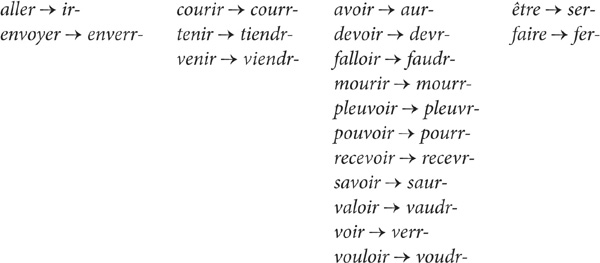
-Er verbs that have a spelling change before a silent e in the present (for example, payer → je paie, appeler → j’appelle, and acheter → j’achète) make this change in the future too, since the last e is silent when it is part of the future stem (je paierai, j’appellerai, and j’achèterai).
Uses
The future tense in French is used
1. to express an action or state that will happen or exist.
2. in Type 1 conditional sentences, where the if-clause is in the present. (See Quick Check on page 105.)
Si vous étudiez, vous réussirez.
3. after quand, lorsque, dès que, and aussitôt que when future time is meant.
Quand il arrivera, nous dînerons. (He’s not here yet.)
Je vous l’expliquerai, dès que je le comprendrai moi-même. (I don’t understand yet.)
Other future forms
Like to go plus an infinitive in English, the present tense of aller plus the infinitive of the main verb can express future time or intention in French.
Je vais chanter demain.
 Conditional tenses
Conditional tensesDefinition
Many grammarians do not consider the conditional to be a true tense, but rather a mood. We consider it a tense here, however, since this analysis will make its parallels with French obvious.
Forms
The conditional tense is formed with the auxiliary verb would plus the infinitive of the main verb.

The conditional progressive tense is formed with the conditional of the verb to be plus the present participle. It therefore requires three words.

Would is often contracted to ’d.
I’d go if you did.
Uses
The conditional is used
1. in Type 2 conditional sentences (If CONDITION, (then) RESULT.).
If I were rich, (then) I would go to Europe every year.
2. to convey the future from a past perspective.

 Conditional tense
Conditional tenseDefinition
In French, the conditional is often considered a mood rather than a tense, since it expresses speculation, not facts. This distinction, however, has no practical effect on its forms or uses.
Forms
The conditional tense is formed with the future stem (see page 93) and the imparfait endings (see page 91). All verbs follow this pattern.
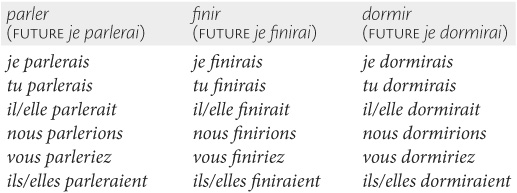
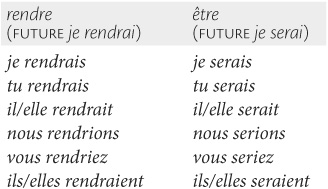
Since the conditional stem is the same as the future stem, the same rules apply for spelling-change verbs (see page 93): j’appellerais, je paierais, j’achèterais, etc.
Uses
Like the English conditional, the conditional in French is used
1. in Type 2 conditional sentences (Si CONDITION [imparfait], RESULT [conditional].). (See Quick Check on page 105.)
Si j’ étais riche, j’irais en Europe tous les ans.
2. to convey the future from a past perspective.
Dimanche Jean a dit: “OK, je vous verrai lundi.”
Mardi Robert dit: “Jean a dit qu’il nous verrait lundi.”
 Perfect tenses
Perfect tensesDefinition
Perfect tenses express
1. the time of the action or state.
2. the fact that it is completed.
“Perfect” in this sense comes from Latin perfectus, meaning “finished” or “completed.” If something has been perfected, it needs no further work. “Perfect” here, then, does not mean “ideal.”
Types
There are four perfect tenses corresponding to each of the tenses already discussed: present, past, future, and conditional.
 Present perfect tense
Present perfect tenseForms
The present perfect tense is formed with the present tense of the verb to have plus the past participle of the main verb.

Uses
This tense indicates that from the point of view of the present time, the action has been completed. Compare the following sentences.
I saw that movie yesterday.
I have seen that movie.
The first sentence, using saw, stresses a past action—what I did yesterday. The second stresses that I am currently experienced with that movie: I now know what it is about, that is, I have (present) seen (completed, finished with) that movie.
An idiomatic use of this tense is associated with the words for and since.
I have tried for three hours to phone him.
I have tried since five o’clock to phone him.
In the first sentence, the present perfect tense implies that there is a momentary lull, but the three hours of trying have lasted up to the present.
 Perfect (compound) tenses
Perfect (compound) tensesForms
All perfect tenses in the active voice are formed with a single auxiliary and the past participle of the main verb. (See pages 83 and 85 for participle formation.)
Types
In French, there is a perfect tense that corresponds to each of the simple (one-word) tenses. These perfect tenses are used much as their English counterparts, except for the first, the passé composé, since its use differs greatly from the English tense formed in the same way. One of these tenses will not be studied: the passé surcomposé, which is used only in literary works (see Appendix D).
 Passé composé
Passé composéForms
The passé composé is formed with the present tense of the auxiliary verb plus the past participle of the main verb.
AUXILIARIES French, like German and Italian, has two possible auxiliary verbs. In fact, English had a second form at one time (The hour is come), but it is now considered obsolete.
Avoir is the more common French auxiliary and is used with a large majority of verbs. Être is used
1. with a small group of verbs (fewer than 20)—all intransitive, many expressing motion. Verbs that are formed from these verbs by adding a prefix also use être (for example, venir → revenir, devenir, parvenir, etc.).
Some of these verbs may be used transitively. For example, monter can mean “to go up” (intransitive) or “to carry up” (transitive).

Avoir must be used in sentences that have direct objects (that is, where the verb is transitive).
2. with any verb that is used reflexively or reciprocally.

For help in remembering the verbs that commonly use être as their auxiliary, study the illustration on the next page.
 Present perfect progressive tense
Present perfect progressive tenseDefinition
All progressive tenses emphasize duration, and all are conjugated with the auxiliary verb to be plus the present participle of the main verb.
Forms
The present perfect progressive tense in English uses to be in the present perfect with the main verb expressed by its present participle.

Uses
Like other progressive tenses, the present perfect progressive tense emphasizes duration. Consider the following sentences.
I have tried since five o’clock to phone him.
I have been trying for three hours to phone him.
The second sentence stresses how long the three hours have seemed to us.
La Maison d’être: Common verbs that use être as their auxiliary

 Passè composè (continued)
Passè composè (continued)AGREEMENT OF THE PAST PARTICIPLE When a past participle is used as an adjective, it agrees with the noun it modifies, as expected.

When used as part of a perfect tense, the past participle follows one of two rules for agreement.
1. Intransitive verbs conjugated with être agree with the subject.
Elle est morte.
Nous sommes venus.
2. All other verbs agree with the direct object if it comes before the verb.
Voici une maison. Les Dupont l’ ont vendue et c’est celle que Paul a achetée.
Care must be taken with reflexive pronoun objects. Ils se sont vus is clear, but some reflexive pronouns are indirect objects. In such cases, there is no agreement.
Ils se sont dit bonjour.
 QUICK CHECK
QUICK CHECK
The following rules apply to all perfect (compound) tenses, not just the passé composé.

WORD ORDER The auxiliary verb—the one that is conjugated—typically fills the same position in the sentence that a simple-tense verb would hold, and the past participle is placed at the end.
 QUICK CHECK
QUICK CHECK

Uses
The passé composé in French is used like the simple past tense in English—not like the present perfect tense, which looks like the passé composé. The passé composé refers to a completed action; the imperfect tense is used for other situations. (See page 91 for contrasting uses of these two tenses.)
 Past perfect (pluperfect) tense
Past perfect (pluperfect) tenseDefinition
The past perfect tense indicates that some action (or state) was completed before some other past action (or state).
Forms
The past perfect tense is formed with the simple past tense of the auxiliary verb to have plus the past participle of the main verb.

These forms are often contracted to I’d, you’d, and so on.
I ’d returned the book before you asked for it.
Uses
Think of the past time sequence in terms of “yesterday” (past) and “last week” (further in the past).
Mary had finished her homework before I began to talk to her.

 Past perfect progressive tense
Past perfect progressive tenseDefinition
This tense shares characteristics with others that have been introduced. It is
1. past (in terms of time).
2. perfect (in the sense of “completed”).
3. progressive (with stress on duration).
Forms
The past perfect progressive tense is formed with the past perfect tense of the verb to be plus the present participle of the main verb.

Uses
This tense expresses an action (or state) that had been continuing just before another past action (or state).
I had been waiting for three weeks when the letter arrived.
That is, the wait started three weeks ago and continued up to yesterday, when the letter arrived.
 Past perfect (pluperfect) tense
Past perfect (pluperfect) tenseForms
The past perfect tense in French is formed with the imperfect tense of the auxiliary (avoir or être) plus the past participle of the main verb.
Uses
Just as in English, the past perfect tense in French refers to an action or state completed further in the past than some other past action or state.
Marie avait fini son devoir, donc j’ ai commencé à lui parler.

 Future perfect tense
Future perfect tenseDefinition
This tense expresses an action that will be completed at some time in the future.
Forms
The future perfect tense is formed with the future tense of the auxiliary to have plus the past participle of the main verb.

These forms are often contracted, especially in speech, to I’ll’ve, you’ll’ve, and so on.
Uses
This tense is used to express future completion.
I will have finished the book before the professor gives an exam.

In the second clause, the present tense is used in English, even though the verb refers to an action in the future; the professor is not giving an exam now.
 Future perfect progressive tense
Future perfect progressive tenseDefinition
This tense expresses an action or state that will be continued and then completed in the future.
Forms
The future perfect progressive tense is formed with the future perfect tense of the auxiliary to be plus the present participle of the main verb.

Uses
This tense is used to emphasize the duration of an action whose beginning point is not specified but whose completion (at least provisionally) will be in the future.
I will have been studying English for 16 years when I graduate.

Although graduation is in the future, English uses the present tense. The sentence does not indicate when the speaker will graduate, nor when he or she began to study English. The important point is the relationship between the verbs in the two clauses; 16 years of study will be completed at the moment in the future when I graduate.
 Future perfect tense
Future perfect tenseForms
The future perfect tense is formed with the auxiliary in the future tense plus the past participle.
Uses
The future perfect tense is used
1. as in English.
2. after quand, lorsque, dès que, and aussitôt que to express a future completed action, even though English uses the present tense (see page 88).

 Conditional perfect tense
Conditional perfect tenseForms
This tense is formed with the conditional tense of to have plus the past participle of the main verb.

These forms are often contracted, especially in speech, to I’d’ve, you’d’ve, and so on.
I’d’ve come if I’d known.
Uses
This tense is used primarily in the result clauses of Type 3 conditional sentences (see below).

The ’d in English can be a contraction of both had and would. This can cause some confusion unless the meaning of a sentence is analyzed.
If he’d said he needed it, I’d have given it to him.

 QUICK CHECK
QUICK CHECK
THE THREE MOST COMMON TYPES OF CONDITIONAL SENTENCES IN ENGLISH

 Conditional perfect progressive tense
Conditional perfect progressive tenseForms
This tense is formed with the conditional perfect tense of the auxiliary to be plus the present participle of the main verb.

Uses
The conditional perfect progressive tense is used in the same way as the conditional perfect, except that the idea of duration is added.
I would not have been sleeping when you arrived, if I had known you were coming.

 Conditional perfect tense
Conditional perfect tenseForms
This tense is formed with the conditional of the auxiliary plus the past participle of the main verb.
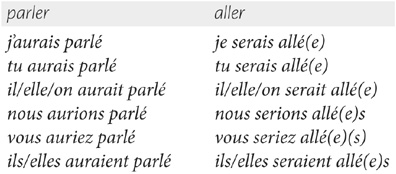
Uses
In French, the conditional perfect tense is used, as in English, primarily for Type 3 conditional sentences.

 QUICK CHECK
QUICK CHECK
THE THREE TYPES OF CONDITIONAL SENTENCES IN FRENCH

 Passive voice
Passive voiceDefinition
The passive voice is used when the subject receives the action of the verb.

Notice that the direct object of the active verb becomes the subject of the passive verb. The active verb’s subject is placed after the passive verb in a prepositional phrase and is called the agent. It is not always expressed, as in the colloquial John got caught; for such a sentence, it is either not important or not known by whom or what John was caught.
Forms
The passive voice is formed with to be or to get plus the past participle of the main verb.
Only transitive verbs (ones that have a direct object) can be made passive.

All the perfect and progressive tenses of the passive voice are formed in the same way. Some forms can be very long and are seldom used; an example of the passive future progressive follows.
The work will have been being done at 3 P.M.
 Passive voice
Passive voiceForms
The passive voice in French is formed with the verb être plus the past participle of the main verb acting like an adjective, that is, agreeing with the subject. The passive voice is used in all tenses.
Agency (expressed with English “by”) is usually expressed by par in French, although de is sometimes used.

In French, the passive voice in all tenses is formed with the appropriate tense of être plus the past participle of the main verb.
Uses
The French prefer the active voice to the passive. (English teachers often suggest using the passive voice as a way of improving one’s writing, and authors sometimes even tend to use less vivid language when writing in the passive.) Compare the following English sentences.

If speakers of English are less than enthusiastic about the passive, the French actively dislike it. As a result, it is seldom used. There are a number of ways to avoid the passive voice in French.
1. Turn the sentence around.
NOT Le livre a été lu par la classe.
BUT La classe a lu le livre.
2. Use on.
NOT Le français est parlé ici.
BUT Ici on parle français.
3. Use the reflexive.
NOT Hier les robes étaient vendues à bas prix.BUT Hier les robes se vendaient à bas prix.
 Imperative mood
Imperative moodDefinition
The imperative mood is the mood used to give commands.
Forms
The forms of the English imperative are very similar to those of the present indicative, with a few exceptions.
The second-person imperative (both singular and plural) has only one form: Sing!
For the first-person plural, the auxiliary verb let is used.
Let’s sing!
For the third-person (singular and plural), the auxiliary verbs let, have, and make are used.
Let her sing!
Have them come in!
Make him stop!
No subject is expressed in an imperative sentence.
IRREGULAR IMPERATIVES English has only one irregular imperative: for the verb to be. Compare the following sentences.

 Imperative mood
Imperative moodForms
The imperative mood in French has three forms: the second-person familiar, the second-person formal, and the first-person plural (the let’s form in English). These forms are the same as those of the indicative except that
1. the subject is not expressed.
2. the -s drops from the ending of -er verbs in the singular.

In the second-person familiar imperative form, the second-person singular -s ending of -er verbs is retained before the object pronouns y and en.
Vas-y.
Parles-en un peu.
For the third-person command, the subjunctive mood is used (see pages 111 and 113–114). The notion “I want” is understood.

IRREGULAR IMPERATIVES Only four French verbs have irregular forms in the imperative mood.

Veuillez is the form used to make a request.

WORD ORDER In affirmative commands, pronoun objects follow the verb and are attached to it by a hyphen. The direct object always precedes the indirect object (see page 27).

In negative commands, the objects are in their normal position and order.

 Subjunctive mood
Subjunctive moodDefinition
The subjunctive is the mood that expresses what may be true.
Forms
The present subjunctive (or the auxiliary verb in a compound tense) has the same form for all persons: the basic (infinitive) form of the verb. It is different from the indicative only for
1. the third-person singular.
that he take
that she have
2. the verb to be.

 Subjunctive mood
Subjunctive moodForms
Subjunctive tenses are fully conjugated in French. (Only the present and past tenses of the subjunctive are presented here; the imperfect and pluperfect subjunctive tenses are rarely used.) The present subjunctive is formed as follows.

The subjunctive forms of most -er verbs are exactly like the indicative forms except for the first- and second-person plural.

Que is placed before the subjunctive forms above to show that these forms are used only in subordinate clauses (even if the main clause is not expressed).
IRREGULAR SUBJUNCTIVES Only two French verbs have irregular endings in the present subjunctive.
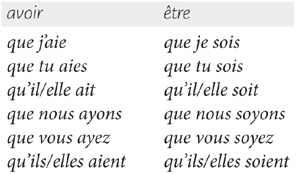
Other verbs have an irregular stem but use the regular subjunctive endings.

In addition, a number of verbs that change the stem for the nous and vous forms in the present indicative also change the stem in the present subjunctive.

The past subjunctive is easily recognized, since its forms are the same as those for the passé composé except that the auxiliary verb is in the present subjunctive.
que j’aie parlé
qu’elle soit venue
 Subjunctive mood (continued)
Subjunctive mood (continued)Uses
The subjunctive is rarely used in English. For that reason, it tends to be disregarded except in certain fixed expressions. Nevertheless, it does have some specific uses that are important in formal English.
1. In contrary-to-fact conditions
If I were you...
“If this be madness, yet there is method in it.” (Hamlet)
2. After verbs like wish, suppose, insist, urge, demand, ask, recommend, and suggest
I wish that he were able to come.
They insisted that we be present.
I recommend that she learn the subjunctive.
3. After some impersonal expressions, such as it is necessary and it is important
It is important that he avoid errors.
It is necessary that Mary see its importance.
4. In certain fixed expressions
So be it!
Long live the Queen!
Heaven forbid !
Far be it from me to suggest that!
Most of these fixed expressions express a third-person imperative; the idea “I wish that” is implied, but not expressed.
Except for the fixed expressions, English speakers tend to use an alternative expression whenever possible, usually with modal verbs (auxiliaries), to avoid the subjunctive in conversation and informal writing. Compare the following sentences with the examples above.
I wish that he could come.
I told her that she must learn the subjunctive.
It is important for him to avoid errors.
Mary needs to see its importance.
 Subjunctive mood (continued)
Subjunctive mood (continued)Uses
In theory, the subjunctive is used to express that something is
1. potentially (but not actually) true.
2. colored by emotion (which often distorts facts).
3. an attitude about something (rather than an actual fact).
4. doubtful, probably nonexistent, or simply untrue.
In practice, there are certain words and expressions that require the subjunctive. Theory may help a French learner remember which ones require the subjunctive, but theory must yield to practice. If an expression requires the subjunctive, it must be used, whether or not one believes that it accords with theory.
The subjunctive is used principally
1. after verbs and expressions conveying the subject’s emotional reactions.
je suis content que...
il craint que...
elles regrettent que...
2. after verbs such as vouloir, supposer, exiger, and demander when there is a change of subject.
Je veux qu’il vienne.
Je veux venir.
In the second example above, the infinitive is used because there is no change of subject.
3. after impersonal expressions when uncertainty is conveyed. Compare the following lists of expressions.
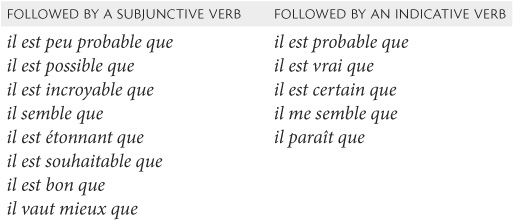
4. after conjunctions expressing the following ideas.

 Subjunctive mood (continued)
Subjunctive mood (continued)5. after superlatives (because of the possibility of exaggeration). Compare the following sentences.
C’est le plus beau poème que je connaisse. (a personal opinion, therefore subjunctive) New York est la plus grande ville que j’ ai jamais visitée. (a fact, therefore indicative)
The first sentence expresses an emotion, the second expresses a fact; the subjunctive and indicative signal how a statement is meant to be understood. Some native French speakers do not make this distinction and use the subjunctive in every case.
6. after certain verbs (especially penser and croire) in the negative and interrogative. (Asking what someone thinks, or saying what someone does not believe, implies doubt about the actual situation.) The negative-interrogative Ne pensez-vous pas que...? often takes the indicative because a positive response is expected.
7. in third-person commands (see page 109).
8. in certain fixed expressions.
Vive le roi!
À Dieu ne plaise!
To remember the principal uses of the subjunctive in French, the mnemonic “SWAP NEEDS” may be used.
Seeming
Wishing
Asking
Possibility
Necessity
Emotion
Exaggeration
Demanding
Supposing
How to avoid the subjunctive in French
The subjunctive is used only in subordinate clauses (even if the main clause is not expressed) and only when the subjects of the two clauses are different. If the subject is the same, you may avoid the subjunctive by using
1. the infinitive. Compare the following sentences.
Je suis content que vous soyez ici. (different subjects)
Je suis content d’être ici. (same subject)
2. an impersonal expression with an indirect object pronoun. Compare the following sentences.
Il faut que je parte.
Il me faut partir. (not as common in everyday use)